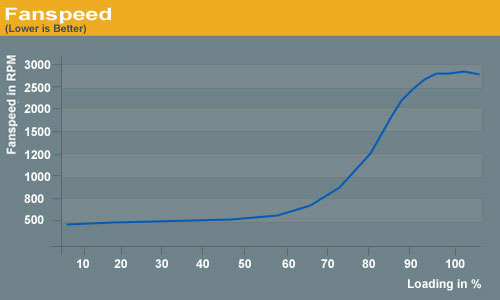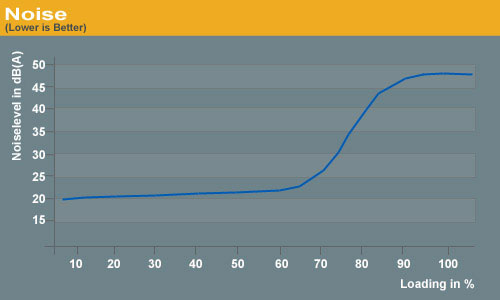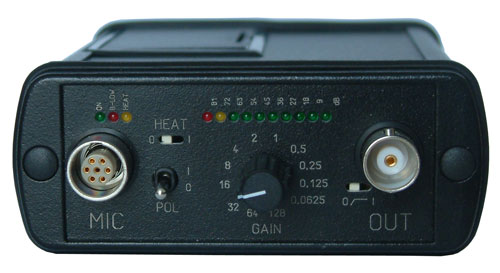AnandTech Power Supply Test Methodology
by Christoph Katzer on July 12, 2007 12:00 AM EST- Posted in
- Cases/Cooling/PSUs
Fan Speed and Resulting Sound Pressure Level (SPL)
The fan speed and the actual temperature of the heatsinks are completely dependent on each other. If the fan(s) turn slowly the heat inside of the power supply will increase as there will be a lack of heat dissipation from the heatsinks. However, the sound pressure level will drop. Conversely, if the fan speed increases the temperatures get better inside the power supply, because the airflow helps to dissipate the heat. The difficulty comes in balancing the desire for lower temperatures with a competing desire for lower noise levels.
Some companies use slower rotating fans in their power supplies to promote quiet/silent products; unfortunately, they don't mention anything about heat levels that can increase tremendously. The fan of the power supply is not only there to cool down the unit itself but also to help exhaust air from the PC. If you have a very slow rotating fan installed the heat of the system will increase, which increases the heat in the power supply as well. The result is a generally hotter system - hotter CPUs, GPUs, hard drives, memory, etc. - and a very sweaty power supply with drooping DC voltages. This, incidentally, is one of the advantages OEM PCs have over their DIY siblings: the OEM is in control of all aspects of the system, and thus is able to determine an optimal configuration of fans, PSU, etc. The best custom-built PCs should take a similar approach, and simply looking for silence without regards to temperatures can lead to unwanted results.
Companies that promote silent power supplies need to have a very good architecture for the printed circuit board and very high-quality components on it. If they skimp in either area, the components are certain to fail at some point. A good indication of a PSU that generates less heat is the stated efficiency. The more efficient a power supply is working, the less heat will need to be dissipated through the coolers. A few years ago such high-quality designs were uncommon at best but companies wanted to have silent power supplies. The result was that most of the units failed after a short time because of overheating.
The art each company needs to master is running the fan speed at an acceptable noise level. There are companies that don't say a word about it and others which stick to their policy that a healthy power supply is a cooled power supply. One of the latter companies is Enermax which says that they know they don't have the quietest power supplies because they prefer the fan(s) to cool the unit to a level that prevents heat-related failures. The user can be sure whey will get very good heat dissipation, but they will also need to get used to increasing noise levels when fully loaded.
To get an impression of how the fan contributes to the cooling of the power supply as well as the resulting noise levels we will test several features. First we measure the actual fan speed in rotations per minute (RPM). This is done with our digital RPM measuring instrument that uses a laser to detect the passing of a white dot placed on the blades, and the frequency is then converted into RPMs.

Sample Fanspeed
To measure the produced noise we have build an anechoic room in which we can measure the noise down to just 15 dB(A). There are simply no power supplies (except fanless models) that can reach this level under this sort of test, but at the same time we will be able to differentiate between varying levels of near-silence. In addition to the sound pressure level we will perform a spectrum analysis to show the different levels of noise produced by the fan at various frequencies.

Sample Noise
The Microphone
To get precise measurements of the noise we need something more than your typical headset-microphone. Even with professional microphones there are big differences which can result in a bad reading. There are many kinds of microphones which are totally inappropriate for test measurements of power supplies or other components. Cardioids-type microphones are pretty much useless since they are designed for directional use within a bigger space and not at all for short distances. The only microphones appropriate for these kinds of measurements are free-field microphones.

Our Microphone is a 0.5" free-field condenser measuring capsule from the renowned German specialist Microtech Gefell.

Microtech Gefell is also the manufacturer of our measuring amplifier. It adjusts the dynamic range of the measuring signal to the input dynamic of the connected PC with which we are analyzing the results.
The fan speed and the actual temperature of the heatsinks are completely dependent on each other. If the fan(s) turn slowly the heat inside of the power supply will increase as there will be a lack of heat dissipation from the heatsinks. However, the sound pressure level will drop. Conversely, if the fan speed increases the temperatures get better inside the power supply, because the airflow helps to dissipate the heat. The difficulty comes in balancing the desire for lower temperatures with a competing desire for lower noise levels.
Some companies use slower rotating fans in their power supplies to promote quiet/silent products; unfortunately, they don't mention anything about heat levels that can increase tremendously. The fan of the power supply is not only there to cool down the unit itself but also to help exhaust air from the PC. If you have a very slow rotating fan installed the heat of the system will increase, which increases the heat in the power supply as well. The result is a generally hotter system - hotter CPUs, GPUs, hard drives, memory, etc. - and a very sweaty power supply with drooping DC voltages. This, incidentally, is one of the advantages OEM PCs have over their DIY siblings: the OEM is in control of all aspects of the system, and thus is able to determine an optimal configuration of fans, PSU, etc. The best custom-built PCs should take a similar approach, and simply looking for silence without regards to temperatures can lead to unwanted results.
Companies that promote silent power supplies need to have a very good architecture for the printed circuit board and very high-quality components on it. If they skimp in either area, the components are certain to fail at some point. A good indication of a PSU that generates less heat is the stated efficiency. The more efficient a power supply is working, the less heat will need to be dissipated through the coolers. A few years ago such high-quality designs were uncommon at best but companies wanted to have silent power supplies. The result was that most of the units failed after a short time because of overheating.
The art each company needs to master is running the fan speed at an acceptable noise level. There are companies that don't say a word about it and others which stick to their policy that a healthy power supply is a cooled power supply. One of the latter companies is Enermax which says that they know they don't have the quietest power supplies because they prefer the fan(s) to cool the unit to a level that prevents heat-related failures. The user can be sure whey will get very good heat dissipation, but they will also need to get used to increasing noise levels when fully loaded.
To get an impression of how the fan contributes to the cooling of the power supply as well as the resulting noise levels we will test several features. First we measure the actual fan speed in rotations per minute (RPM). This is done with our digital RPM measuring instrument that uses a laser to detect the passing of a white dot placed on the blades, and the frequency is then converted into RPMs.

Sample Fanspeed
To measure the produced noise we have build an anechoic room in which we can measure the noise down to just 15 dB(A). There are simply no power supplies (except fanless models) that can reach this level under this sort of test, but at the same time we will be able to differentiate between varying levels of near-silence. In addition to the sound pressure level we will perform a spectrum analysis to show the different levels of noise produced by the fan at various frequencies.

Sample Noise
The Microphone
To get precise measurements of the noise we need something more than your typical headset-microphone. Even with professional microphones there are big differences which can result in a bad reading. There are many kinds of microphones which are totally inappropriate for test measurements of power supplies or other components. Cardioids-type microphones are pretty much useless since they are designed for directional use within a bigger space and not at all for short distances. The only microphones appropriate for these kinds of measurements are free-field microphones.

Our Microphone is a 0.5" free-field condenser measuring capsule from the renowned German specialist Microtech Gefell.

Microtech Gefell is also the manufacturer of our measuring amplifier. It adjusts the dynamic range of the measuring signal to the input dynamic of the connected PC with which we are analyzing the results.










49 Comments
View All Comments
Adul - Thursday, July 12, 2007 - link
I'd love to see a power supply catch fire :). Maybe one of the cheaper ones will break enough for this.CrystalBay - Thursday, July 12, 2007 - link
I would also like to see a short video of substandard PSU's lighting up...I'm sure many enthusiasts have had Dram's start flaming or smoke. But I have never had a PSU actually catch flame out....
Martimus - Thursday, July 12, 2007 - link
I had a Antec NeoPower PSU spew black smoke. It was not fun. Also fried my motherboard. It was less than 6 months old too, and I wasn't using it at anywhere near it's supposed capacity.BladeVenom - Thursday, July 12, 2007 - link
Then test power supplies that are in the range that most people actually need. Also test some budget ones. Let's see which ones are good for the money, and which ones are fire hazards.
xsilver - Thursday, July 12, 2007 - link
what is meant is that the idea of having a psu is NOT to load it to 100% capacity.and the problem being that it is very difficult to get a stable and repeatable psu testing setup.
I highly recommend that industrial manufacturers be pointed out just like in xbit labs reviews. That way we will know that antec has 3 or more suppliers providing psu's and be able to tell the seasonics from the other crud ;)
Wesleyrpg - Thursday, July 12, 2007 - link
hmm i wonder if thats why some people rave about Antec and some people like me curse them! I'd have to say Antec have the worst failure rate by far, probably at about 75% in the first year, where i can buy a $22 550W Generic (Honli) and only have about a 25% failure rate, maybe thats related to the power supplys released into australia by antec.imaheadcase - Thursday, July 12, 2007 - link
I kid! :Pgersson - Thursday, July 12, 2007 - link
just a red 'X'gersson - Thursday, July 12, 2007 - link
nevermind -- working already :-)